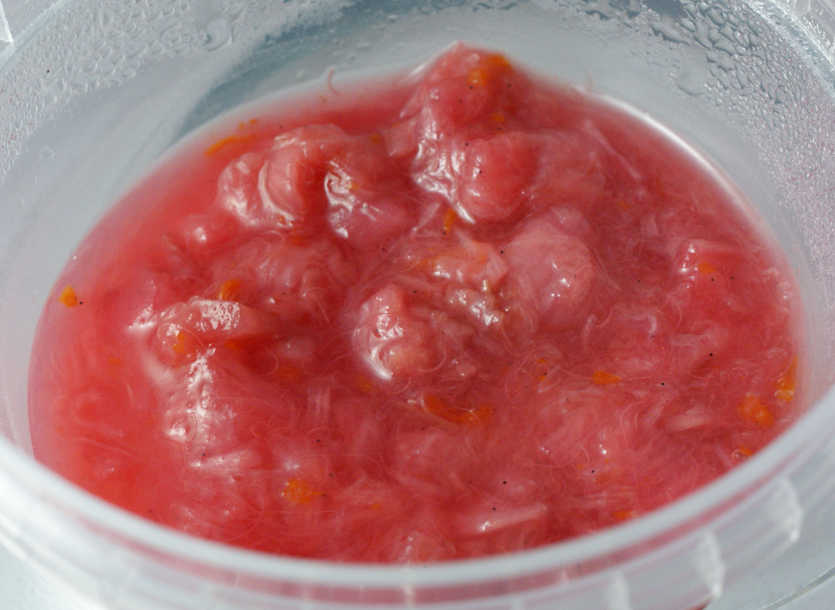
Bloody Valentine
A Prevernal Valentine dinner - that's pre-spring to you! You know, when Valentine's Day happens.
It's not yet spring - there still might be snowmaggedon. But neither is it still winter 'cos it's wet and muddy.
One of the Ecological seasons.
Which are quite handy when you need something finer-grained for your culinary calendar.
In fact it wasn't even on Valentine's Day, which would have seemed either presumptuous or desperate considering Flora and Pete are a steady item, whereas Callum and Flora-Two are definitely not. So I settled for the day after, which is handily a Saturday.
'Tis, however the season for Yorkshire Forced RhubarbPDO from the famed rhubarb triangle, so an ideal opportunity to showcase their wares.
I was hoping to entice over a new couple of victims - Rob and Tara. Rara are both a new couple and new victims, or they would be if they'd come. I had a meal plan and everything - working around a Tournedos Rossini to accommodate Rob's hatred of fish and all things fishy.
But they couldn't make it, so I adapted the menu slightly to make it a little less flesh-oriented and a little more girl-friendly.
A little.
In fact it wasn't even on Valentine's Day, which would have seemed either presumptuous or desperate considering Flora and Pete are a steady item, whereas Callum and Flora-Two are definitely not. So I settled for the day after, which is handily a Saturday.
'Tis, however the season for Yorkshire Forced RhubarbPDO from the famed rhubarb triangle, so an ideal opportunity to showcase their wares.
I was hoping to entice over a new couple of victims - Rob and Tara. Rara are both a new couple and new victims, or they would be if they'd come. I had a meal plan and everything - working around a Tournedos Rossini to accommodate Rob's hatred of fish and all things fishy.
But they couldn't make it, so I adapted the menu slightly to make it a little less flesh-oriented and a little more girl-friendly.
A little.
menu
Sundries
Beer Bread
Foie Gras Terrine
Starter
Strawberry Dressed mixed leaf salad
Main Course
Confit Duck
Pan-fried Foie Gras
Foie Gras Terrine
Creamed Spinach
Dessert
Yorkshire Forced Rhubarb Crème Brûlée
Beer Bread
Foie Gras Terrine
Delicious on beer bread, or as part of a main course ensemble!
Starter
Strawberry Dressed mixed leaf salad
and
Homemade Black Puddings
In regular, chocolate and apple.
Served with red onion marmalade, Mole Poblano sauce and scrumpy reduction as appropriate.
Served with red onion marmalade, Mole Poblano sauce and scrumpy reduction as appropriate.
Main Course
Confit Duck
Pan-fried Foie Gras
Foie Gras Terrine
Assembled together on a smear of Rhubarb Chutney
accompanied by:
Jerusalem Artichokes
with Beurre Blancaccompanied by:
Creamed Spinach
Dessert
Yorkshire Forced Rhubarb Crème Brûlée
Decorated with dried strawberry slices
and jus de fraises.
I actually gave this meal plan a fair bit of thought -
I must be learning! Or growing old?
Sick of ending up having a hundred ingredients all needing to prepared the same way at the same time - usually fried, I arranged a fairly even distribution of frying [black puddings, foie gras, roasting [confit duck], simmering [beurre blanc], boiling [artichokes], baking [brûlées] steaming [sauces], and microwaving [spinach]. Plus a good dose of advanced preparation [sauces, puddings (in both senses!), pâté, and spinach].
Hell I even had time to set the table, light candles and have a shower!
About a week earlier I made the black puddings (which was a whole rock-and-roll time in itself!) and the foie gras terrine. A few days before D-Day I made up the confit duck to give it time to develop. That left the brûlées for the night before (so they had time to chill overnight), and then the bread, creamed spinach, salad, dressing and sauces to prepare in plenty of time on the day.
Just before the guests were due (yes, they were late. Flora was with them. Flora is always late) I made up the beurre blanc and strained it into a warmed wide-necked thermos to keep stable, and set the various sauces to warm up in a bain-marie in a low oven.
Which all made the serving itself pretty smooth:
- Here's how I plated the starter:
Pile a little warmed red onion marmalade to one side of the plate, lean the fried regular slice of black pudding jauntily against it, then the chocolate slice, then the apple. Drizzle the Mole Poblano sauce over the chocolate slice and the scrumpy reduction over the apple, adding a few tiny apple cubes for extra points. Decorate the plate with the strawberry dressed salad.
- And for the main course pacé Alan Murchison:
After frying the foie gras I drained off the excess fat from the pan, then de-glazed with a dash of Sherry vinegar until it bubbled into a thick sauce, then poured that over the foie gras set aside in a warming dish.
I placed a quenelle of the creamed spinach on each place, arranged a small stack of jerusalem artichoke slices and dressed with the beurre blanc. Next a generous smear of the rhubarb chutney across the centre then laid on shreds of the confit duck, thin chunks of the foie gras terrine and hunks of the pan-fried foie gras. Dribble around a few pan juices and garnish with micro cress leaves or a selection of that delightful strawberry dressed salad you cleverly held back from the starter.
And by the way - it was fucking delicious.
Sick of ending up having a hundred ingredients all needing to prepared the same way at the same time - usually fried, I arranged a fairly even distribution of frying [black puddings, foie gras, roasting [confit duck], simmering [beurre blanc], boiling [artichokes], baking [brûlées] steaming [sauces], and microwaving [spinach]. Plus a good dose of advanced preparation [sauces, puddings (in both senses!), pâté, and spinach].
Hell I even had time to set the table, light candles and have a shower!
About a week earlier I made the black puddings (which was a whole rock-and-roll time in itself!) and the foie gras terrine. A few days before D-Day I made up the confit duck to give it time to develop. That left the brûlées for the night before (so they had time to chill overnight), and then the bread, creamed spinach, salad, dressing and sauces to prepare in plenty of time on the day.
Just before the guests were due (yes, they were late. Flora was with them. Flora is always late) I made up the beurre blanc and strained it into a warmed wide-necked thermos to keep stable, and set the various sauces to warm up in a bain-marie in a low oven.
Which all made the serving itself pretty smooth:
- Fry the black puddings and serve the starter.
- Put the artichokes on to boil and the confit duck to roast.
- Eat starter.
- Fry the foie gras, microwave the spinach, strain and dress the artichokes, shred the duck, plate and serve.
- Eat main course.
- Attempt to turn out the crème brûlées, fail, glaze them in their pots with a blowtorch. Serve.
- Eat dessert
- Here's how I plated the starter:
Pile a little warmed red onion marmalade to one side of the plate, lean the fried regular slice of black pudding jauntily against it, then the chocolate slice, then the apple. Drizzle the Mole Poblano sauce over the chocolate slice and the scrumpy reduction over the apple, adding a few tiny apple cubes for extra points. Decorate the plate with the strawberry dressed salad.
- And for the main course pacé Alan Murchison:
After frying the foie gras I drained off the excess fat from the pan, then de-glazed with a dash of Sherry vinegar until it bubbled into a thick sauce, then poured that over the foie gras set aside in a warming dish.
I placed a quenelle of the creamed spinach on each place, arranged a small stack of jerusalem artichoke slices and dressed with the beurre blanc. Next a generous smear of the rhubarb chutney across the centre then laid on shreds of the confit duck, thin chunks of the foie gras terrine and hunks of the pan-fried foie gras. Dribble around a few pan juices and garnish with micro cress leaves or a selection of that delightful strawberry dressed salad you cleverly held back from the starter.
And by the way - it was fucking delicious.
Foie Gras Pâté. Or is it a Terrine?
Pressed Foie Gras Terrine
fowl starter snack ingredient
So I finally cracked the whole foie gras pâté thing. Turned I was doing it all wrong.
And it's amazing how badly it can go!
Karl's rules for less-than-awful Foie Gras Terrine:
Karl's rules for less-than-awful Foie Gras Terrine:
- Number One: Don't over-marinate the liver - 6 hours seemed plenty.
- Number Two: It's all about the internal temperature - you absolutely must stop when it reaches 40°C. Any more and the terrine will just melt away.
- Number Three: You need to really empty the juices from the cooked terrine, or it will turn out all watery and full of holes.
- Number Four: Really press that stuff, or it will just fall apart like a cheap suit.
Makes 300g
Ingredients
- 1 duck or goose liver (about 1½lb)
- 1½ tblsps Armagnac
- 1½-2 tblsps Sauternes
- grating nutmeg
- grinding of pepper
- ½ tsp salt
Carefully prise open the liver lobes and pick out as many of the veins and outer membrane as you can manage without destroying the whole thing.
It helps if you do this with the liver chilled, and wearing latex gloves so as not to melt it unduly whilst you manhandle it.
Use toothpicks or a paring knife to chase out the veins, starting with the fat ones connecting the lobes.
Mix up the marinade ingredients, then layer the liver pieces as tightly as possible into a terrine or small loaf tin. Splash some marinade over each layer. Try and get the best-formed liver pieces to line the bottom and sides of the terrine, as if rebuilding the lobes, so it will look smooth and pretty when you turn it out.
Cover with cling-film and marinate for 4 hours or as preferred in the fridge, then a couple more hours while it comes up to room temperature.
Fill a deep baking tin with enough water to come well up the sides of the terrine, and adjust the oven temperature until the water holds at 70°C.
Re-cover the terrine tightly with cling-film if it needs it, place it in the water-filled tin, then cook for about 25 minutes until the centre of the paté reaches 40°C. you could even try pouring out the liver pieces into a strainer, but they're pretty delicate and I think they'd just break up.
Now settle the liver pieces back into the terrine, pour back in enough fat just to cover, tightly recover with cling film, and use a close fitting piece of card, plastic or the base of a smaller terrine and a heavy weight to firmly press down the terrine for an hour at room temperature.
Now you can put the terrine in the fridge until needed securing the cling-film it shouldn't need the weight any more, it will taste best if you leave it for a few days.
To serve, peel off the cling-film and cut away any paté that's leaked up the sides. Briefly dump the terrine in boiling water, then invert onto a plate and turn out.
Mix up the marinade ingredients, then layer the liver pieces as tightly as possible into a terrine or small loaf tin. Splash some marinade over each layer. Try and get the best-formed liver pieces to line the bottom and sides of the terrine, as if rebuilding the lobes, so it will look smooth and pretty when you turn it out.
Cover with cling-film and marinate for 4 hours or as preferred in the fridge, then a couple more hours while it comes up to room temperature.
Fill a deep baking tin with enough water to come well up the sides of the terrine, and adjust the oven temperature until the water holds at 70°C.
Re-cover the terrine tightly with cling-film if it needs it, place it in the water-filled tin, then cook for about 25 minutes until the centre of the paté reaches 40°C. you could even try pouring out the liver pieces into a strainer, but they're pretty delicate and I think they'd just break up.
Now settle the liver pieces back into the terrine, pour back in enough fat just to cover, tightly recover with cling film, and use a close fitting piece of card, plastic or the base of a smaller terrine and a heavy weight to firmly press down the terrine for an hour at room temperature.
Now you can put the terrine in the fridge until needed securing the cling-film it shouldn't need the weight any more, it will taste best if you leave it for a few days.
To serve, peel off the cling-film and cut away any paté that's leaked up the sides. Briefly dump the terrine in boiling water, then invert onto a plate and turn out.
Magical. When you get it right.
Drek when you don't. Expensive drek.
Drek when you don't. Expensive drek.
Confit Duck Legs
fowl main ingredient crockpot
According to the Cooking for Geeks guy
it's the time and temperature
not the technique (which is lucky). Or the fat.
Obviously duck fat would be ideal, but goose fat is just fine, olive oil acceptable and even water (apparently) would work just the same.
You need the temperature to be above 68°C when the collagen will start to denature, but below 97°C to avoid steaming the meat. Whatever. Just watch the temperature like a hawk people.
You might be able to control your oven temperature accurately enough to cook the legs in a casserole dish, but I used a slow cooker, lid off with a candy thermometer sticking out of the top the whole time so I could keep a wary eye on it. I set the cooker to Warm, which held at about 60°C, then adjusted some tin-foil wrapping around it until it stayed at the higher ideal temperature. My slow cooker's Low setting being about 85°C - slightly too hot.
Start off with the fat at the temperature your aiming for. Or higher. Before adding the cold legs.
Obviously duck fat would be ideal, but goose fat is just fine, olive oil acceptable and even water (apparently) would work just the same.
You need the temperature to be above 68°C when the collagen will start to denature, but below 97°C to avoid steaming the meat. Whatever. Just watch the temperature like a hawk people.
You might be able to control your oven temperature accurately enough to cook the legs in a casserole dish, but I used a slow cooker, lid off with a candy thermometer sticking out of the top the whole time so I could keep a wary eye on it. I set the cooker to Warm, which held at about 60°C, then adjusted some tin-foil wrapping around it until it stayed at the higher ideal temperature. My slow cooker's Low setting being about 85°C - slightly too hot.
Start off with the fat at the temperature your aiming for. Or higher. Before adding the cold legs.
Serves 6
Ingredients
- 6 duck legs
- 60g salt
- 3 bay leaves, crumbled
- 1 tablespoon thyme leaves
- 1 tablespoon (about 1 sprig) rosemary leaves
- 1 teaspoon (about 18) juniper berries, crushed
- 1 tsp peppercorns, cracked
- about 1 litre/1kg fat
Grind the herbs roughly in a mortar with some of the salt to break them up a little (you don't need to powder them).
Roughly grind the peppercorns in a mortar to crack them open.
Crush the junipers.
Mix the salt and spices and rub the duck legs all over.
Place them skin-side down in a single layer in a non-corrosive container, cover them with cling-film, weight them down and leave to marinate for about 24 hours.
Thoroughly rinse all the marinade off the duck legs or they really will be salty, and pat them dry carefully. Immerse them in the fat making sure they're completely submerged (use something to weigh them under if necessary) and cook them at 77°C for at least 6 hours. 8-12 is better.
When done, you can just leave them to cool in the fat if you're planning on using them soon, but if you want to preserve them for any length of time you'll need to take them out of the pot, separate off the fat from the juices which will have sunk to the bottom of the pot, reheat and strain the fat. Now you can re-cover the legs with the cleaned fat, but you don't want the legs to be touching the bottom or sides, so first pour a layer of fat into your preserving container, chill it, lay the legs on top and cover completely with more fat.
They should now keep for months. Probably.
When you finally want to eat them, prise them out of the container and scrape off as much fat as you can. You can now eat them as they come, say in a salad. Or a sandwich. Great for picnics.
If you want to reheat them there are (reputedly) about five ways to go:
Roughly grind the peppercorns in a mortar to crack them open.
Crush the junipers.
Mix the salt and spices and rub the duck legs all over.
Place them skin-side down in a single layer in a non-corrosive container, cover them with cling-film, weight them down and leave to marinate for about 24 hours.
I'd say mine were verging towards over-salted so depending on how you like your confit,
you might take them out 12 hours earlier or try less salt.
Feel free to select your own combination of herbs and spices. Garlic is quite popular too. Here are some other people's ideas.
Preheat a pot of your chosen fat in a slow cooker or oven.
Throw in a few bay leaves, sprigs of rosemary, peppercorns, garlic cloves or whatever you fancy for flavour.Feel free to select your own combination of herbs and spices. Garlic is quite popular too. Here are some other people's ideas.
Thoroughly rinse all the marinade off the duck legs or they really will be salty, and pat them dry carefully. Immerse them in the fat making sure they're completely submerged (use something to weigh them under if necessary) and cook them at 77°C for at least 6 hours. 8-12 is better.
When done, you can just leave them to cool in the fat if you're planning on using them soon, but if you want to preserve them for any length of time you'll need to take them out of the pot, separate off the fat from the juices which will have sunk to the bottom of the pot, reheat and strain the fat. Now you can re-cover the legs with the cleaned fat, but you don't want the legs to be touching the bottom or sides, so first pour a layer of fat into your preserving container, chill it, lay the legs on top and cover completely with more fat.
They should now keep for months. Probably.
When you finally want to eat them, prise them out of the container and scrape off as much fat as you can. You can now eat them as they come, say in a salad. Or a sandwich. Great for picnics.
If you want to reheat them there are (reputedly) about five ways to go:
- grill them skin-side until crispy (or broil them - as our American cousins have it)
- roast them in a hot oven for 15-30 minutes until crisp.
Yeah, good luck with that!
I tried just roasting them skin-side down in a baking tin in a hot oven, but to be honest the result was disappointing. The skin failed to crisp and it really dried out the meat. I'll try another way and get back to you, but I fancy grilling or frying/roasting for being most likely to work. - pan-fry them, skin side down until the skin crisps up, then turn to finish
- the fry/roast combo - fry them skin side down to crisp them up, turn skin-side up and put the pan in a low oven for 15 minutes to heat through.
Difficult to get the skin to crisp in the pan due to the rounded shape of the (now) stiff duck leg.
I might try grilling next time! - deep-frying Sounds explosive!
Classic!
Rhubarb Chutney
veg vegan ingredient sauce
A rather sharp, intrusive jam-like sauce that goes well with rich foie gras.
Makes about 1 cup
Ingredients
- 300g of rhubarb
- 230g of sugar
- 170ml of water
- 1 vanilla pod
- 10g of orange zest
- 10g of fresh ginger, grated
Roughly cut the rhubarb into 10 cm pieces.
Place the rhubarb, sugar, water and vanilla into 1 large vac pac bag.
Poach at 80°C until it just starts to go soft (approximately 8 minutes).
Alternatively, poach in a bowl in a double boiler until softened (about 15 minutes).
If all else fails, you can combine all the ingredients in a small sauce pan and poach until tender.
Strain the rhubarb, reserving the liquid and allow to cool.
Finely dice the rhubarb or slice attractively and combine with the orange and ginger liquid. Correct the consistency if required by adding liquid from the rhubarb syrup until you have a jam like texture. Set aside until ready to serve
You really need to pull out your rhubarb at the first hint of softening as it collapses very quickly.
Peel and grate the ginger. Combine with orange zest and place in a pan,
cover with 100ml of the cooking liquid from the rhubarb and cook gently until soft.Finely dice the rhubarb or slice attractively and combine with the orange and ginger liquid. Correct the consistency if required by adding liquid from the rhubarb syrup until you have a jam like texture. Set aside until ready to serve
The original recipe called for 30g of ginger but I found that way too hot.
I only used a half of the orange and ginger liquid, which gave an acceptable balance.
I figure 10g might work better. 15g at the most.
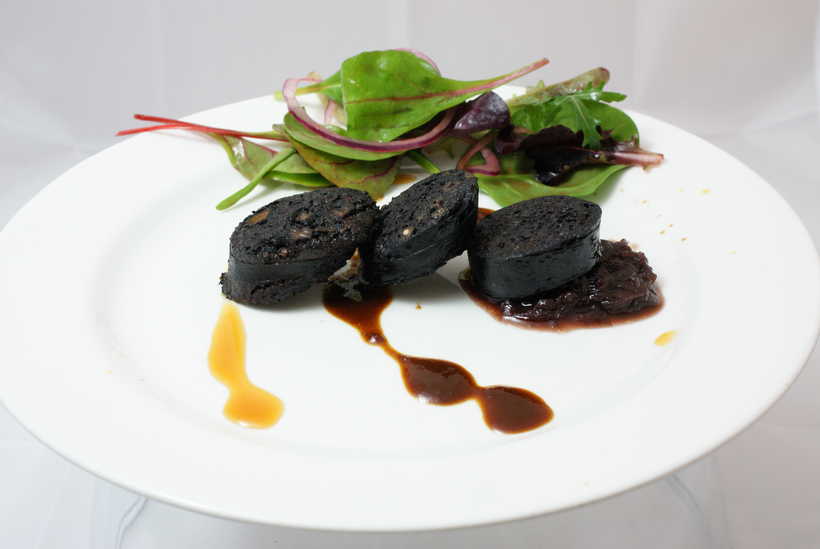
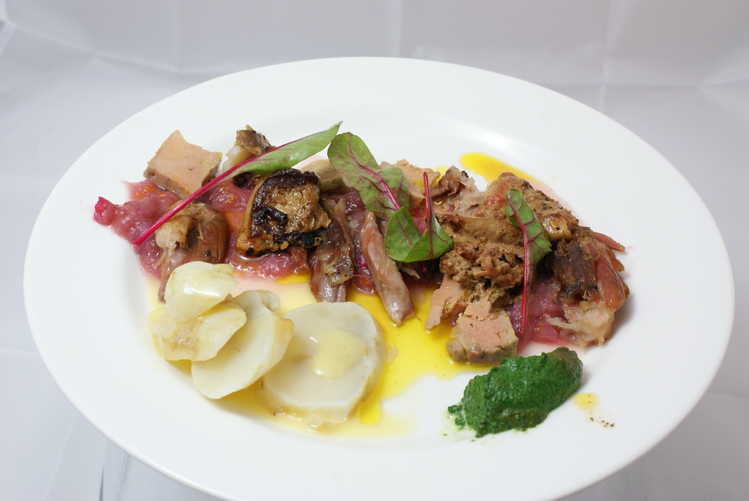
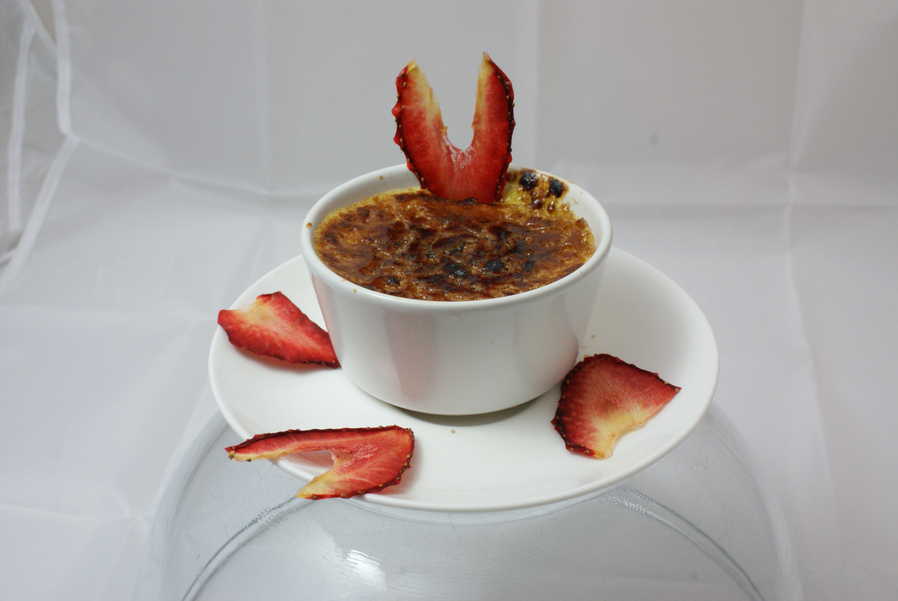
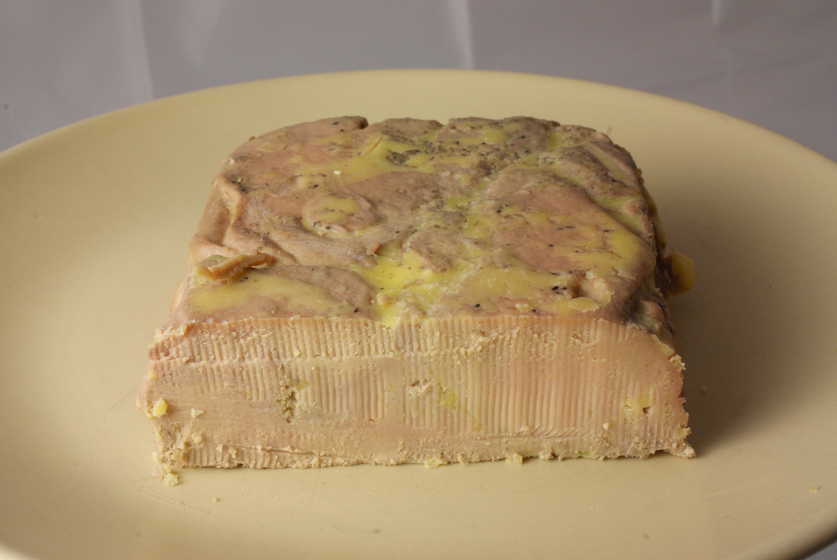
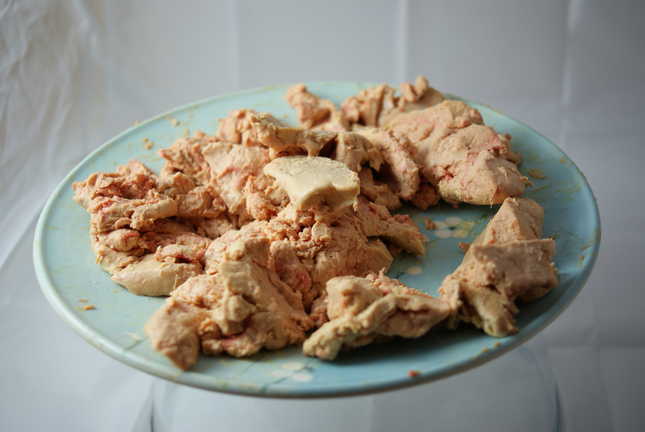
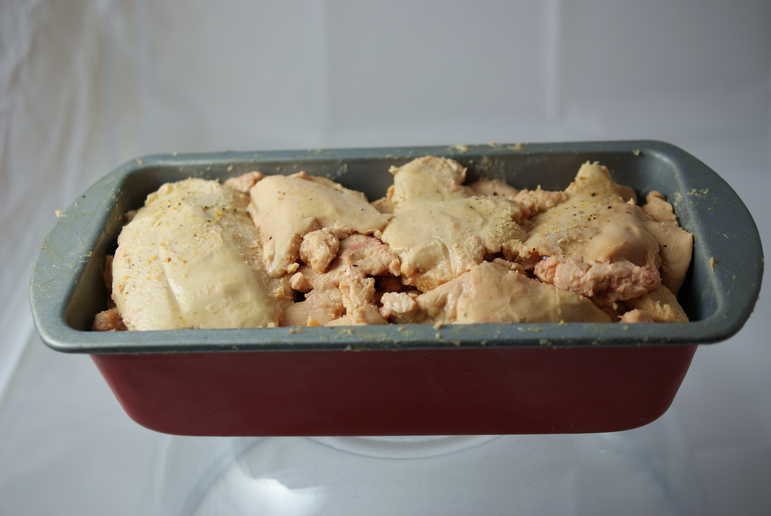
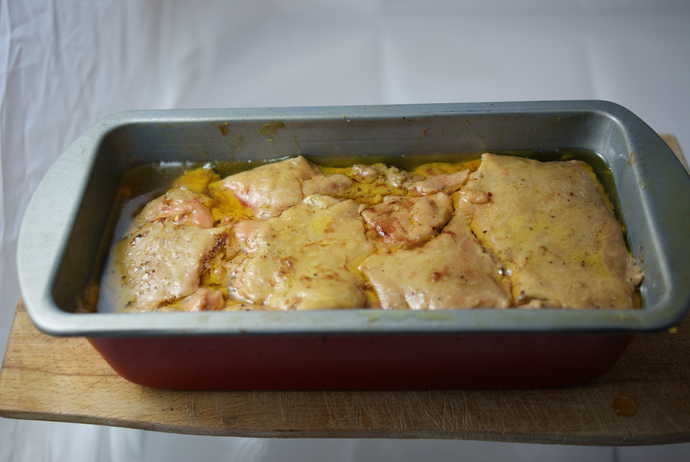

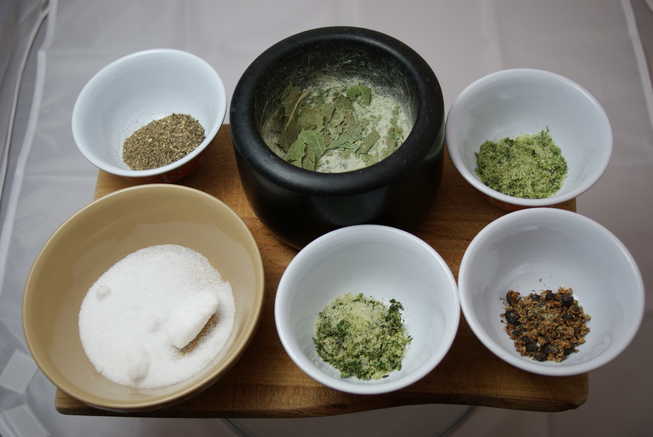
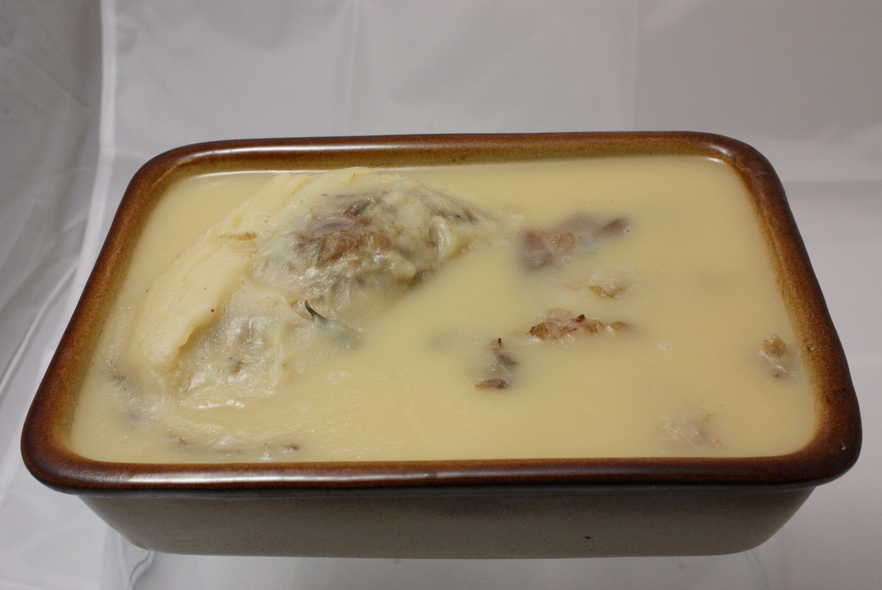
Inserting a temperature probe you can monitor in the oven into the paté is ideal though.